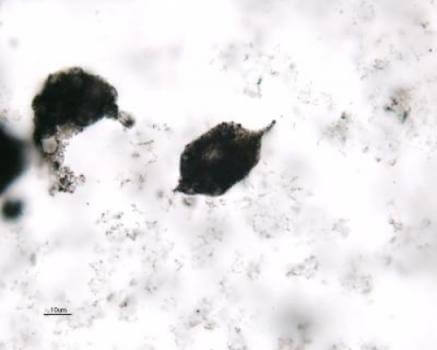"It is surprising to discover relatively large and perhaps even complex fossils at such an early geological time," says Christopher House, Professor of Earth Sciences at Penn State University, the lead researcher on the study.

Spindle-like shapes embedded in three-billion-year-old rocks are microfossils or plankton that probably populated the oceans all over the world at that time. This is according to a study by a team of researchers from the USA and Japan.
"It is surprising to discover relatively large and perhaps even complex fossils at such an early geological time," says Christopher House, Professor of Earth Sciences at Penn State University, the lead researcher on the study.
The researchers showed that apart from the fact that the origin of these forms inside the rocks was biological, they were also probably planktonic autotrophs - tiny creatures that floated freely in the oceans and that produced energy from their environment.
The researchers examined marine sedimentary rocks from Farrel Quartzite in Western Australia. Isotopic analysis using an ion mass spectrometer was performed at UCLA.
"Prof. Kenichiro Sugitani, a professor at the School of Environmental Studies at Nagoya University in Japan and co-author of the paper, discovered that these microfossils were embedded in ancient rock," House said.
To determine whether the origin of these formations is biological, the researchers examined 15 different samples of Halamish and measured the stable carbon isotopes. The proportion of carbon 13 in microfossils is evidence that the material was formed by biological processes. They discovered that the proportion of carbon-13 in the organic matter in the rock itself was different from that within these microscopic structures.
"When we also performed comparative morphological tests, it was clear that the microstructures in Halamish are necessarily microfossils and in particular we proved that they originate from plankton."
The researchers reported the finding in the current issue of the journal Geology. The morphological and chemical studies were carried out by Dorothy Oler of NASA's Science Administration at the Johnson Space Center.
The length of these formations ranges from 20 to 60 microns, about the size of a grain of sand and within the size range of modern microplankton.
Isotopic analysis of the stable carbon can help determine the biological origin of the microfossils because they use carbon dioxide to create energy (through the process of photosynthesis) and they incorporate the carbon in their bodies. In this process, the organisms selectively incorporate more carbon-12 than carbon-13 from the available carbon and produce the biological signature.
Oller comments that these skills are similar to those found in the Strelly Pool formation in Western Australia and the Onverwacht rock in South Africa and Switzerland, all 3.4 billion years old.
"The existence of microfossils in remote areas in the period 3.4 billion years ago indicates that the oceans contained life for a very long time," says Oller. "Furthermore, the finding has implications beyond our single study – it shows that the evolution of the diversity of life has acted rapidly."

2 תגובות
How do you know that these microscopic structures are really ancient biological creatures and not just dirt from another material in the rock?
After all, they don't have a skeleton or clear organs.
For me personally, the article strengthens the argument regarding the possible correctness of the panspermia theory...
Hanan Sabat
http://WWW.EURA.ORG.IL